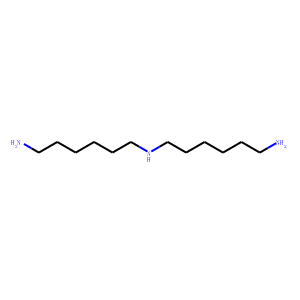| Reference | <div>
1. Biochem Mol Biol Int. 1996 Apr;38(5):1003-11.Dissociation between effects of polyamines on mitochondrial calcium uptake and mitochondrial permeability transition by elongation of polyamine methylene backbone. Rustenbeck I(1), Reiter H, Lenzen S.</div>
<div>
</div>
<div>
The aliphatic polyamine bis(hexamethylene)triamine, a spermidine analogue, was found to lack the enhancing effect on mitochondrial Ca(2+) accumulation which is typical for the natural polyamines, spermidine and spermine. However, like spermine and spermidine, this compound had a significant inhibitory effect on the Ca(2+) and Pi-induced mitochondrial permeability transition. By chromatographic determination of the amount of polyamines bound to mitochondria after a 2 min incubation, it was found that the binding affinity was spermine > or = bis(hexamethylene)triamine > spermidine. There was no competition between binding of spermine and of bis(hexamethylene)triamine. It is concluded that membrane binding sites of bis(hexamethylene)triamine are different from those of spermine. This different membrane interaction is apparently caused by the elongated hydrophobic spans in bis(hexamethylene)triamine and leads to a loss of the effect on Ca(2+) uptake but leaves intact the inhibitory effect on membrane permeability transition.<br />
<br />
2. Langmuir. 2019 Apr 30;35(17):5779-5786. doi: 10.1021/acs.langmuir.8b03584. Epub 2019 Feb 11.Preparation and Evaluation of Antimicrobial Hyperbranched Emulsifiers for Waterborne Coatings.Zhao P(1), Mecozzi F(1), Wessel S(2), Fieten B(3), Driesse M(3), Woudstra W(2),Busscher HJ(2), van der Mei HC(2), Loontjens TJA(1).</div>
<div>
</div>
<div>
Nosocomial infections are a major problem in medical health care. To solve this problem, a series of antimicrobial waterborne paints were prepared by using antimicrobial hyperbranched (HB) emulsifiers. The HB-emulsifiers were prepared by polymerizing AB2 monomers obtained in a one-step reaction of bis(hexamethylene)triamine and carbonyl biscaprolactam. <br />
<br />
3.Dalton Trans. 2017 May 30;46(21):6975-6984. doi: 10.1039/c7dt00529f.Amphiphilic coatings for the protection of upconverting nanoparticles against dissolution in aqueous media.Plohl O(1), Kralj S, Majaron B, Fröhlich E, Ponikvar-Svet M, Makovec D, Lisjak D.</div>
<div>
</div>
<div>
Two amphiphilic coatings, poly(maleic anhydride-alt-1-octadecene)-bis(hexamethylene)triamine (PMAO-BHMT) and d-α-tocopheryl polyethylene glycol succinate (TPGS) were tested for their effects on the dissolution of the UCNPs. The coatings were formed directly on the as-synthesized UCNPs as was confirmed with electrokinetic measurements, infrared spectroscopy and thermogravimetric analyses. Both coatings enabled the dispersion of UCNPs in water, and improved the fluorescence emission intensity with respect to the bare UCNPs. However, only the PMAO-BHMT coating provided an </div>
<div>
effective protection against the dissolution of the UCNPs and long-term colloidal stability in PBS, and did not show cytotoxicity in EAhy926 endothelial cells.</div>
<div>
</div>
|

